Alclad II Lacquer Natural Metal Finishes
By Bob King, Originally published June 2013
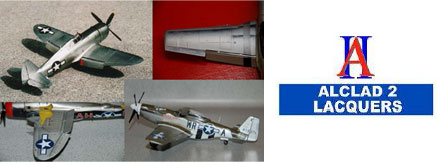
Alclad II is a cellulose based lacquer that dries almost instantly.
It has seventeen natural metal finishes, four
prismatic colors, three plastic base coat/
primers, and six transparent colors. It will
produce a wide range of realistic and durable
metal finishes on aircraft, cars, trucks, armor
and figures. It is pre-thinned for airbrush use
and no buffing is required.
A list of Alclad II finishes is as follows:
|
Natural Metal Finish (NMF):
- 101 Aluminum
- 102 Duraluminum
- 103 Dark Aluminum
- 104 Pale Burnt Metal
- 106 White Aluminum
- 108 Gold
- 110 Copper
- 111 Magnesium
- 112 Steel
- 113 Jet Exhaust
- 116 Semi-Matte Aluminum
- 117 Dull Aluminum
High Shine Shades: (translucent shades)
- 105 Polished Aluminum
- 107 Chrome
- 115 Stainless Steel
- 118 Gold Titianium
- 119 Airframe Aluminum
|
Prismatic Finishes:
- 201 Scarabeus blue-to-green
- 202 Maple Copper red-to-green
- 203 Jade green-to-gold
- 204 Sapphire deep blue-to-ultra violet/purple
Primer/Base coats:
- 302 Gray primer
- 303 Clear base
- 304/305 Gloss Black-2 & 4oz.
Transparent Colors:
- 400 Medium 401 Red
- 402 Yellow/Gold 403 Blue
- 404 Green 405 Black/Smoke
|
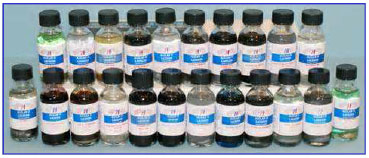
Important: One must prime the plastic
model before using Alclad II.
The primers protect the plastic from a crazed finish due to
microscopic weaknesses in the plastic surface. I have used
and recommend the following:
Tamiya Silver Leaf spray: The primer is very thin. It will
not cover any detail and looks like a very bright shiny aluminum.
Is also excellent primer base for panel shading with Alclad II transparent
smoke.
Tamiya Semi Gloss Black spray: This primer coat is also thin. It will
produce a finish that is not too shiny. It works well on the engine
portion of the fuselage to provide a contrast with the remainder
of the fuselage that has been primed with the above mentioned silver
leaf. It is also an excellent base for a radial engine. It seems
to add weight to the metal finish.
Alclad II Clear base: The manufacturer states that the new high shine
shade airframe aluminum looks very good over their primer. I have
tried it and it leaves a bright shine.
Gloss Black enamel: This is an excellent primer for high shine finishes
of chrome or highly polished metals since it traps most of the light
falling on it. Or for that matter any gloss black surface. The chrome
shade will only produce a robust finish when applied over a dark
gloss base coat. Their enamel base coat needs several days to cure
before applying the Alclad II shade.
Acrylic Auto Primer/Krylon: This works well on resin parts as well as
styrene plastic. Sand it with 1000/1200 wet/dry sandpaper. This
primer is very fragile. One should be careful not to sand through
to the bare plastic. This is really important if you are polishing
over an angle or raised surface. It is very hard to re-prime and
cover Alclad II on such a small area without having an inconsistent
finish.
Alclad II Gloss Black base: You should allow this primer
coat to dry 24 hours, It is very easy to use since it is already
thinned and ready to airbrush out of the bottle. It is surprisingly
transparent and it is often necessary to apply two coats for complete
coverage. It is very smooth.
Alclad II Gray primer/micro filler: This works well on hairline seams
that need filling. Allow 30 minutes to dry and sand it with micromesh
or ultra fine wet/dry sand paper.
Tamiya Gray/White primer: Be sure to sand the Tamiya primers with 1000/12000
wet/dry sandpaper. This comes out of a spray can and it is really
quick and easy.
Future Floor Finish: This should be allowed to dry completely. I would
not cover it with Alclad II for at least 24 hours. The longer you
can wait the better.
Krylon Gloss Black (a lacquered based spart paint): This is an old favorite.
You must allow it a full day to cure but it provides an excellent
base for a super high gloss finish. It does not go on ultra smooth,
so you should wet sand after it dries.
Caution! Alclad II is loaded with vapors that you should not
breathe over a prolonged period. Alclad II contains the
following: Normal Butanol, Methyl Ethyl Ketone, Methyl
Isobutyl Ketone,and Toluene.
Some Alclad II components are
highly flammable and can cause
slight to severe neurological, liver,
and kidney damage. Exercise more
than a modicum of caution when
using this product.
It is safe to handle and use with
proper precautions. So, use proper
precautions. Use adequate ventilation, in case of eye contact
rinse your eyes with water and if swallowed contact a
physician immediately. Keep out of reach of children.
When spraying with Alclad II use a multi-purpose
professional respirator with cartridges for organic vapors.
Before starting to airbrush, one should always shake the
bottle very well. I immediately shake each color just before
placing it in the airbrush. It really makes a difference.
One should look carefully at the primed surfaces for any
imperfections. If you find one, mask off the area and reprime
with several light coats. Sand until the surface is
perfect. Wipe the model to remove any fingerprints.
This really is important for a black gloss enamel surface that
will be sprayed with a chrome finish.
Alclad II Lacquer must be airbrushed on a surface that has
been primed and cleaned. I spray at 10-15 psi or less. I use a
gravity feed airbrush, so the low pressures work fairly well.
I seldom airbrush more than eight to ten drops at a time.
Apply the Alclad II at approximately a 45° angle or less to
the surface on your initial application. This will allow for a
thin coat that blends evenly across the surface. You should
spray one to two light coats, waiting one to two minutes
between coats. Alclad II will go a long way if you do not
waste it by using more than you need for each application.
When transferring Alclad II to your airbrush use a pipette.
Do not pour it into your airbrush since it is very hard to
control. Transfer less than you think you will need. Be sure
to recap the bottle immediately after using. (I prefer to use
about eight drops at a time.)
Prepare all small parts for your model that you want to
have a natural metal finish. This could include gun barrels,
wheels, radial engines, pilot tubes, etc. Then, after you
have finished spraying your primary surface, empty the
remaining paint in the airbrush on these small parts. I like
to use several shades on these parts for a unique finish.
Once it really looks good, set it aside. (You can do some of
your best work cleaning out the airbrush.)
One needs to guard against spillage by knocking over the
container. The containers are 1 3/16th inches in diameter
and three inches tall and made of glass.
The container must be secured, or it will spill. I use a
cluster of empty bottles in a larger container that serves as a
base. The empty bottles can be used to set pipettes in and
hold enough lacquer thinner for cleaning the airbrush.
You can accommodate different sized bottles by simply
removing or adding various bottle sizes until they wedge
themselves securely together.
One should save the empty glass bottles. They make an
excellent bottle to mix paint and thinner in and they are tall
enough to easily hold the long pipettes.
The best way to save Alclad II is to use less of it. The
darker the primer base, the more Alclad II is needed to
cover it.
I love using Tamiya’s Silver Leaf Spray, TS-30. It requires
only the lightest coat of Alclad II to achieve the desired
natural metal shade. Conversely, one can use Tamiya’s
Semi-Gloss Black, TS-29 as a base coat for Alclad II Jet
Exhaust, on a propeller.
You will use less Alclad II over primers that are closer to
the final shade you are trying to achieve. The exception to
this approach is the use of the High Shine Shades which
most often use a glossy black primer to optimize their
unique light absorbing qualities.
Before starting to spray your model, plan out the sequence
of colors that you want to use on the model. I prefer to use
two basic primer colors.
I first apply an
overall coat of
Tamiya Silver Leaf
TS-30. I then
determine where I
want a uniform
darker color. I mask
and spray that area
with Tamiya Semi-
Gloss Black TS-29.
I prefer to use these
primers because of
their durability and
fast drying time. They are dry to the touch in about 20
minutes, and they will not hide any of the detail on the
model. I then lightly buff the surface with an old t-shirt.
The old t-shirt is very soft and adds not a hint of lint
residue. This light buffing will
remove any primer that has not
adhered to the plastic.
The primers will set the basic
undertone for different areas of
the model. I have used many
variations that I will set forth in
the following section. It is really
fun to experiment with different
shading techniques.
Once your basic primer colors
are in place and you have
determined what shades you will
be using and where, start by
using the darkest shades first.
For example: Start with Steel (112 ), follow with
Magnesium (111), follow that with Duraluminum (102),
then Aluminum (101, then White Aluminum (106) lightly
airbrushed over all of the metal shades.
Alclad II dries fast and is very durable. After I have
applied each shade, I buff the application with a soft cotton
cloth. Next, mask the area and proceed to the next color.
Tamiya masking tape works extremely well over Alclad II.
It will not leave any residue and can be left on the surface for
months. Alclad II dries fast and is very durable.
After you have
finished applying
all of the various
shades, remove
all of the masks
from the natural
metal shades
exposing them
for a very light
coat of White
Aluminum.
This will “unify”
all of the panels and give the model an
overall consistent appearance. Next, you should highlight
the model with shades such as Pale Burnt Metal, Jet Exhaust,
and Transparent Smoke.
Aircraft use different sorts of metal with different grains that
affect the natural metal finishes appearance. By varying
these shades, your aircraft will appear more realistic. The
variations may be achieved several ways.
The panel is first
airbrushed with a coat
of gloss black and it is
followed with a
translucent coat of
Chrome (107). Next,
you spray the center of
the panel with a regular
shade of Aluminum
(101).
This shade is not translucent and therefore appears lighter in
color. After that, follow with another coat of translucent
Chrome(107). The result is variability in surface color.
The panel is first airbrushed with a coat of gloss black.
Then, the inner portion of the panel is sprayed with a glossy
gray. Once you have the black and gray glossy surface the
way you want it, spray the translucent Polished Aluminum
(105),Chrome(107), or Airframe Aluminum(119).
Pre-shade over the Tamiya Silver Leaf Spray TS-30 with any
of the Alclad II darker, regular shades. This is especially
useful when applying an exhaust or oil streak on an aircraft
fuselage. It is easier to cover the exhaust that you do not
want with subsequent applications of regular metal shades.
Transparent Smoke(405) is my favorite method of preshading
aircraft panels. It can be used to simulate a panel
that is not uniform in color or provide a slight contrast to a
nearby panel.
I prefer to use this method by a large margin. It is by far the
most economical way from a time and money standpoint.
Using the regular shades over the transparent smoke uses the
least amount of Alclad II and the finish possibilities are
almost limitless.
I first spray Tamiya Silver Leaf, TS-30, for the base primer
coat. The Alclad Transparent Smoke surface appearance is
somewhere between smoke and blue steel.
Shading is very easy to accomplish since it can be laid down
anywhere between transparent and opaque. It can also be
sprayed directly over the NMF Alclad II shade and then
recoated with another NMF Alclad shade.
It is very versatile. I have also painted with it over Tamiya,
Polly S, and Gunze
Sangyo acrylics and
then repainted over it
with Alclad II NMF
shades. It gives a very
nice effect.
Alclad II regular natural
metal shades may be
tinted with small
amounts of enamel or
auto acrylic. Tint only
the Alclad II that will
be immediately used.
Alclad II High Shine
shades should not be
tinted.
The transparent smoke may be applied so that the base coat
is almost translucent to an opaque blue, black cover. any of
One can use any of the regular shades or high shine shades
over the Silver Leaf and Transparent Smoke combination.
You also have the further option of using a regular shade
over this combination to achieve another variation. These
layers of Silver Leaf and Alclad II are so thin that you are
still able to achieve these effects without the appearance of
“out of scale” paint build up.
It is also easier to achieve the desired result by using your
airbrush to its best advantage. I believe that it is better to
gradually take away what you do not want on the surface,
rather than paint exactly what you want directly onto the
surface with an airbrush. It is especially true when doing
variations on a panel or rendering exhaust stains.
Seldom do I wait much more than ten minutes before
masking for the next shade application. I prefer to mask
with Tamiya masking tape. It has a razor sharp edge and it
holds its place when buffing against it.
I use Scotch 3M Scotch-Blue Painters Tape for Multi-
Surfaces to mask large areas. It is a medium-adhesive mask
that is not too expensive.
Note: When one is removing masking tape from an Alclad II
surface, be careful not to scratch the surface with a fingernail
or x-acto blade. The scratch will not cover with just a second coat
of Alclad II.
After a bit of practice, you do not even need to use masking
tape between panels. You can do a number of shades using
only a 3x5 card, damp paper, or a post-it note for a mask.
Testor’s Metalizer Finishing System does not require a
protective primer to be used over the styrene plastic.
It can be used to touch up an area that you may have sanded
through or created through a masking glitch.
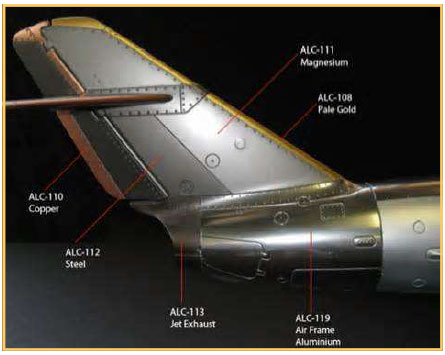
Use it sparingly, but it
can really get you out of
some bad spots. It is
not as durable but it will
give you a beautiful
finish.
Painting over Alclad II
can be done with almost
any other paint. It is a
very good surface to
mask over and, if one is painting with an acrylic or enamel, it
can be removed without harming the original surface. The
acrylic paints adhere quite well to Alclad II. Tamiya acrylic
paints can be easily removed with Windex.
An ultra diluted mixture of Winsor & Newton’s Winton Oil Color Raw Umber and
lighter fluid works very well on Alclad II surfaces.
It should be applied before you clear coat the model for
decaling. If you are unhappy with the results of the panel
highlights, it easily wipes away showing no trace of being
applied. I prefer this solution because it is very subtle.
If it is necessary to remove Alclad II, Gunze Sango thinner
will remove Alclad II and its primer from styrene quickly
and easily without harming it.
This thinner is called Mr. Color Thinner. I call it the magic
elixir. It is an organic solvent that has many applications but
I think this is a really outstanding use for it.
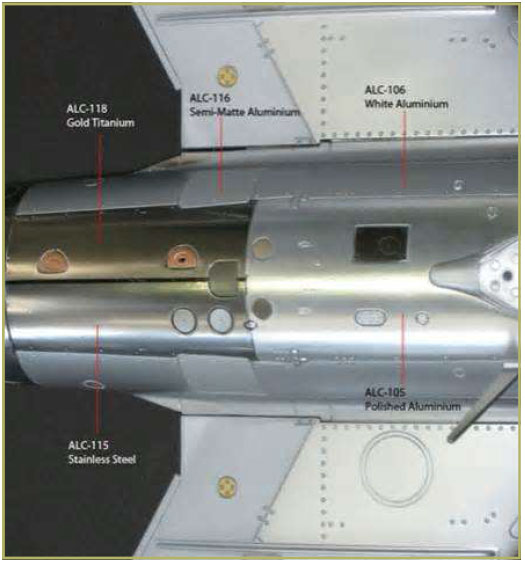
Alclad II regular
metal shades can
be directly
decaled over.
Alclad II high
shine shades
should not be
directly decaled
over because
decal setting
solutions will
mar the finish.
I usually use a
clear coat before
decaling.
Airbrush the
clear coats for
the decals on ultra-light and polish them with 8,000/12,000
micromesh to place and protect them.
If you plan to model an aircraft that is dull and weathered,
use Tamiya Smoke (X-19) for the clear base coat. It is easily
applied and can be easily removed with a rag soaked in
Windex should you want to redo your results. The Alclad II
will not be affected by the Windex.
Prismatic colors should be applied over a glossy dark base.
Alclad Gloss Black Base or Tamiya Gloss Black TS-14 are
excellent base coats.
One should spray prismatic colors at 20 psi using a wide
spray pattern and a large tip. The metallic particles in the
prismatic colors are very large and require a large tip. Cover
the surface with as few passes as possible. The prismatic
colors will appear slightly rough when dry. This is normal.
Overcoat prismatic colors with two coats of clear to obtain a
deep
reflective
finish.
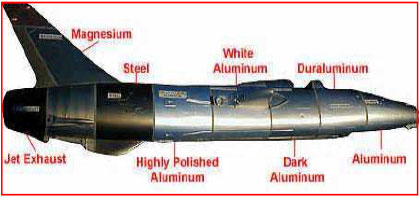
Alclad II is an
outstanding
way to do
natural metal
finishes for model aircraft.
[Editor’s note: Photos on this page courtesy of Alclad II/Tony Hipp.
All others courtesy of Bob King.]
Click here for more articles.
| 